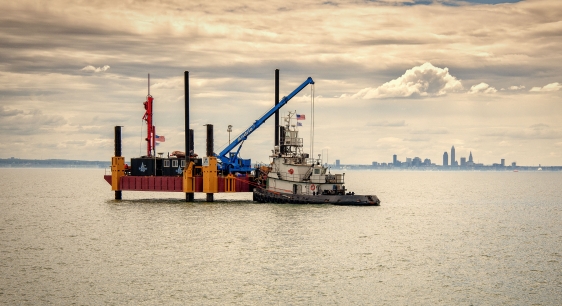
The U.Maine design for a floating turbine platform uses composites instead of steel for floats and an unusual tower to support the turbine. The turbine was launched into the Penobscot River at Cianbro in Brewer Maine. Photo Jeff-Kirlin.jpg
The U.S. offshore industry marked a couple milestones with the launch of its first offshore turbine. And not long before that, a barge on Lake Erie took core samples from the lake bottom in preparation of turbine foundations for a wind farm on the U.S. North Coast.
On the East Coast, the University of Maine’s Advanced Structures & Composites Center and partners recently celebrated the launch of VolturnUS 1:8, the first grid-connected offshore wind turbine deployed off a coast of North America.
The 65-foot-tall turbine prototype is 1/8th scale of a 6-MW turbine (about 750 kW) that is the first floating turbine of its kind in the world, using advanced material systems with a unique floating hull and tower.
Data acquired during the 2013 deployments off nearby islands will be used to optimize the design of the patent-pending VolturnUS system. The UMaine Composites Center partnered with industry leaders to invest in a 12 MW, $96 million pilot farm. The deployments this summer will de-risk the technology in preparation for connecting the first full-scale unit to the grid in 2016.
The program goal is to reduce the cost of offshore wind to compete with other forms of electricity generation without subsidies. Maine has a potential 156 GW of offshore wind capacity within 50 miles of its shores and a plan to deploy 5 GW of offshore wind by 2030. Planners estimate its 5-GW goal could attract $20 billion of private investment to the state, creating thousands of jobs.
The launch of “VolturnUS 1:8 is another signal of steady progress toward development of an American offshore wind industry,” says Christopher Long, Manager of Offshore and Siting Policy for the American Wind Energy Association. The event follows a series of advances for offshore wind over the past year, that Long said includes:

On the North Coast, a jack-up barge with 90-ft. legs was used to perform pressure tests and extract soil samples from Lake Erie where the nonprofit Lake Erie Energy Development Corporation (LEEDCo) plans to erect up to nine 3-MW wind turbines in 2016. The analysis is essential to the company’s effort to build the first freshwater wind farm in America and will ensure the turbines’ foundation tailored to the Lake Erie environment.
- Extension of the Production Tax Credit and the Investment Tax Credit (ITC) for projects that start in 2013. The ITC is particularly important to helping launch the U.S. offshore wind industry because offshore projects are more capital-intensive and have longer permitting timelines. “It will take predictable public policy for the U.S. wind energy industry to achieve all that it’s capable of doing to meet America’s future energy needs and create jobs for the U.S. economy,” Long said.
- Advances by the Bureau of Ocean Energy Management in leasing and permitting offshore wind sites in several areas off the eastern U.S. coast, from Maine to Virginia.
- Launch by the DoE of a multi-year $180 million initiative for advanced technology demonstration projects aimed at reducing the cost of energy from offshore projects. The first round of winners includes seven projects from the Atlantic Coast, Great Lakes, Gulf of Mexico and West Coast. This will leverage private funds that will pay for most project costs.
- A coordinated strategic plan, A National Offshore Wind Strategy: Creating an Offshore Wind Industry in the United States, was released in 2011. A plan goal is to deploy 10 GW of offshore wind capacity by 2020 and 54 GW by 2030.
The VolturnUS technology is the culmination of more than five years of collaborative research and development conducted by the UMaine-led DeepCwind Consortium. The DeepCwind research program is a public-private partnership funded by the DoE, the National Science Foundation-Partners for Innovation, the Maine Technology Institute, the state of Maine, the University of Maine and more than 30 industry partners.
The continued progress toward offshore wind in the U.S. will be the focus of the AWEA Offshore WINDPOWER 2013 Conference & Exhibition, America’s largest annual offshore wind gathering, scheduled for Providence, R.I., October 22-23, 2013.
Filed Under: News, Offshore wind, Projects





i will say what is on the mind of everybody i know with wind experience … took a 100 years to get this far???
How does the power that’s generated up to 50 miles out to sea get back to the land based grid? Is there an undersea cable?